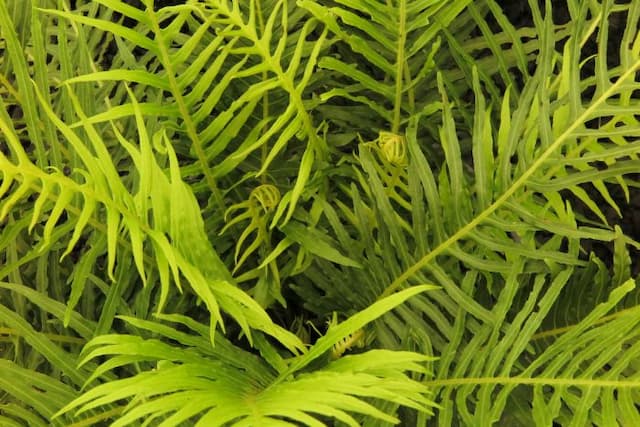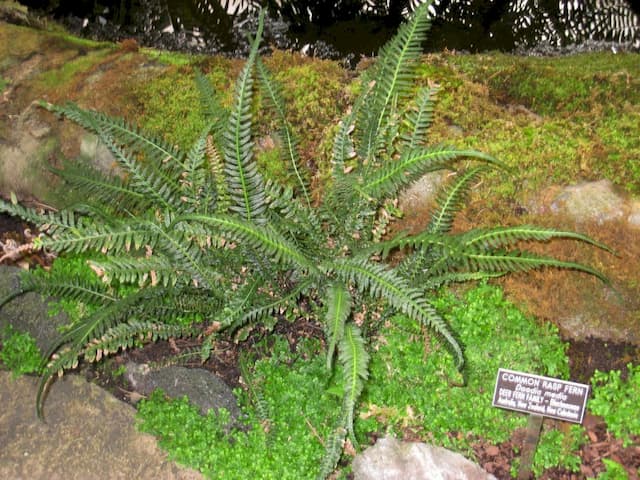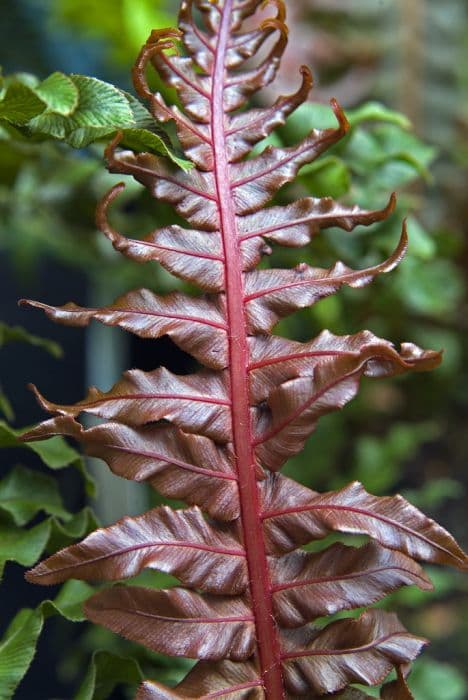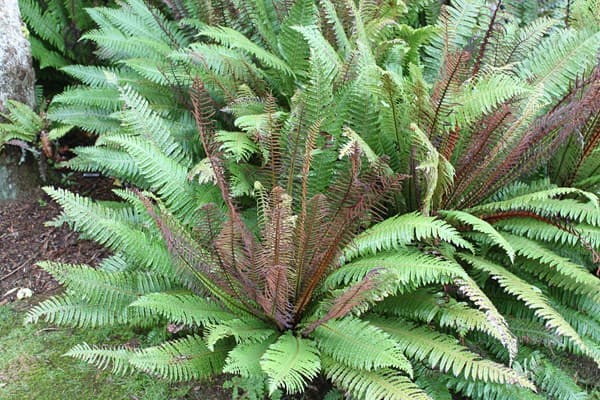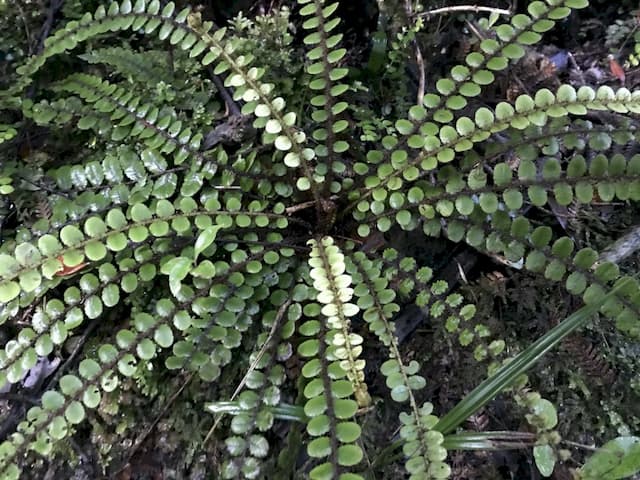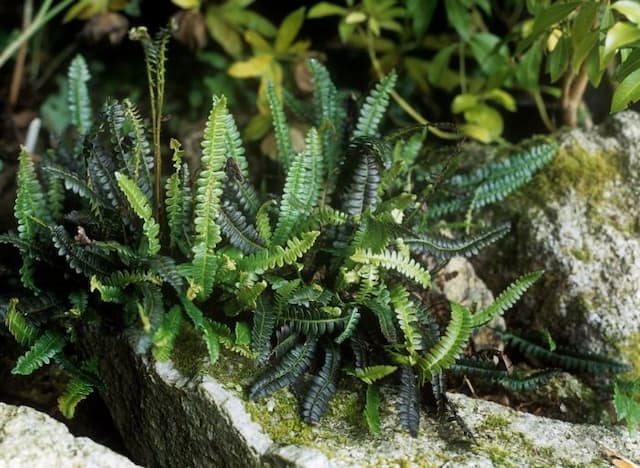Chilean hard fern Blechnum chilense

ABOUT
Commonly known as the Chilean hard fern, this evergreen fern species exhibits a robust and structural appearance. It stands out with its rich, glossy green fronds which are pinnate, meaning the large leaves extend on either side of a central stem, resembling a feather. The fronds are usually leathery to the touch and arch gracefully, contributing to the plant's lush texture. During the initial stages of growth, new fronds emerge with a striking reddish-bronze color before maturing into the characteristic deep green. The foliage arrangement presents a rosette form as it radiates outward from a central point, creating a circular pattern that contributes to the plant's visual interest and dense appearance. The Chilean hard fern also features a distinctive reproductive mechanism where the undersides of its mature fronds bear reproductive structures called sori. These appear as small brown dots or patches and are responsible for dispersal and propagation of the plant. Overall, the Chilean hard fern is known for its striking foliage and the elegance it brings to the environments in which it grows, making it a favored choice for shaded garden areas and for providing year-round greenery.
About this plant
 Names
NamesFamily
Blechnaceae
Synonyms
Chilean Hard Fern, Costilla De Vaca
Common names
Lomaria chilensis, Lomaria lanceolata, Blechnum lanceolatum, Struthiopteris chilensis.
 Toxicity
ToxicityTo humans
The Magellan Blechnum, or more commonly known as the Hard fern, has not been widely reported as a toxic plant to humans. However, like with any plant, some individuals could potentially have an allergic reaction or sensitivity to it. It is always advisable to handle plants with care and to avoid ingesting any parts of unknown plants, as individual responses can vary. As of my knowledge cutoff in 2023, there is no well-documented evidence of significant toxicity in the Hard fern that would lead to common symptoms of plant poisoning such as gastrointestinal upset, skin irritation, or more severe reactions in humans.
To pets
The Hard fern has no widely-known toxic effects on pets either. It is not generally listed among plants that are poisonous to household pets such as dogs and cats. However, it's always prudent to prevent pets from consuming plants, as individual animals might have different sensitivities or allergic reactions. There may also be a lack of extensive research on the potential toxicity of this particular fern to all pet species. It is always best to err on the side of caution and keep pets from ingesting plants not known to be safe.
 Characteristics
CharacteristicsLife cycle
Perennials
Foliage type
Evergreen
Color of leaves
Green
Height
3-5 feet (0.9-1.5 meters)
Spread
3-4 feet (0.9-1.2 meters)
Plant type
Fern
Hardiness zones
7
Native area
South America
Benefits
 General Benefits
General Benefits- Ornamental value: The Chilean Hard Fern's distinctive foliage and structure make it a popular choice for ornamental gardens or as a specimen plant.
- Habitat enrichment: In its native environment, Blechnum chilense contributes to the biodiversity and supports the local ecosystem.
- Shade tolerance: As an understory plant, it is capable of growing in shaded conditions, valuable for landscaping in areas with limited sunlight.
- Soil stabilization: The root system of Blechnum chilense helps in stabilizing soil, preventing erosion on slopes and in forested areas.
- Drought resistance: Once established, this fern can tolerate periods of drought, making it suitable for xeriscaping and reducing the need for irrigation.
- Ease of propagation: The plant can be easily propagated from spores or by division, allowing gardeners to multiply their plants without much difficulty.
 Medical Properties
Medical Properties- This plant is not used for medical purposes.
 Air-purifying Qualities
Air-purifying QualitiesThis plant is not specifically known for air purifying qualities.
 Other Uses
Other Uses- Basket Weaving: The flexible fronds of Blechnum chilense can be used in traditional basket weaving to create sturdy and decorative items.
- Garden Ornamental: The plant is often used as an ornamental in gardens due to its attractive foliage and ease of cultivation in shady areas.
- Livestock Feed: In some areas, the plant is used as a supplementary feed for livestock, although not their primary diet.
- Mulch Production: The fronds, when trimmed, can serve as an effective mulch for garden beds, helping to retain soil moisture and suppress weeds.
- Soil Erosion Control: The robust root system of the plant helps to stabilize soil, making it useful for planting in areas prone to erosion.
- Natural Dyes: Parts of the plant can potentially be used to create natural dyes for textiles, though this use is not widespread.
- Cultural Symbolism: In some cultures, Blechnum chilense may hold symbolic significance and be used in ceremonies or as a part of cultural heritage displays.
- Education and Research: The plant serves as a subject for botanical study and education, helping students and scientists understand fern biology and ecology.
- Water Feature Planting: Due to its moisture-loving nature, it can be used around ponds or water features in landscaping.
- Biomonitoring: It can be useful in biomonitoring as an indicator of environmental conditions, such as soil moisture and shade levels.
Interesting Facts
 Feng Shui
Feng ShuiThe Hard fern is not used in Feng Shui practice.
 Zodiac Sign Compitability
Zodiac Sign CompitabilityThe Hard fern is not used in astrology practice.
 Plant Symbolism
Plant Symbolism- Resilience: Blechnum chilense, commonly known as the Chilean hard fern, often grows in tough, challenging conditions which symbolizes its ability to thrive despite adversity.
- Endurance: The evergreen nature of the Chilean hard fern represents endurance and the capacity to persist through times of change and difficulty.
- Growth: As a fern, it can symbolize new growth, and the unfurling of its fronds can represent the unfolding of new ideas or experiences.
- Solitude: Ferns are often found in solitary spots within forests, so the Chilean hard fern may symbolize a need for solitude or a period of personal growth and introspection.
- Shelter: The dense foliage of the Chilean hard fern can provide shelter to various forest species, thus symbolizing protection and nurturing.
- Ancient wisdom: Ferns are among the oldest groups of plants on Earth, so the Chilean hard fern can symbolize ancient wisdom and a connection to the past.
 Water
WaterThe Chilean hard fern should be watered when the top inch of soil feels dry to the touch. Generally, this would mean watering once every week, but the frequency can increase during hot, dry periods to possibly twice a week. Ensure the water gets deep into the soil to reach the roots, but avoid waterlogging the plant. Depending on the size of the pot, the amount of water can range from 16 to 32 ounces each time you water it. Always check the soil before watering to avoid overwatering and potential root rot.
 Light
LightThe Chilean hard fern thrives best in partial shade but can also tolerate full shade. It is not suited for intense direct sunlight, which can scorch its fronds. A spot with dappled sunlight, such as under the canopy of taller plants or trees, would be ideal for this fern.
 Temperature
TemperatureThe Chilean hard fern prefers a mild climate and does well in temperatures ranging from 50 to 70 degrees Fahrenheit. It can survive minimum temperatures down to about 20 degrees Fahrenheit but will struggle in hotter conditions above 80 degrees. The ideal temperature range endorses healthy growth and maintains the lush green appearance of the fern.
 Pruning
PruningPruning the Chilean hard fern is typically done to remove any dead or damaged fronds and to maintain the plant's shape. It is best to prune in the springtime before the new growth begins. Cut the fronds back to the base of the plant and do this annually or as needed when you notice dead or unsightly fronds.
 Cleaning
CleaningAs needed
 Soil
SoilThe best soil mix for the Magellan Blechnum (the most common name of Blechnum chilense) is rich, well-draining soil with high organic content. The soil pH should be slightly acidic to neutral, ideally ranging between 5.5 and 7.0. A mix of peat, sand, and loamy garden soil can work well to provide the necessary drainage and nutrient retention.
 Repotting
RepottingMagellan Blechnum should be repotted every 2-3 years or when it outgrows its current container. This fern does not like to be overly disturbed, so it is best to repot only when necessary.
 Humidity & Misting
Humidity & MistingMagellan Blechnum thrives in high humidity environments, ideally between 60% and 80%. It is important to maintain consistent humidity levels for the plant to flourish.
 Suitable locations
Suitable locationsIndoor
Place in shade, ensure high humidity and moist soil.
Outdoor
Provide shade, shelter, rich soil, and keep moist.
Hardiness zone
7-10 USDA
 Life cycle
Life cycleBlechnum chilense, commonly known as the Chilean hard fern, begins its life cycle as a spore released from mature ferns. After dispersal, the spores germinate in moist, shaded conditions to form a small, heart-shaped gametophyte known as a prothallus, which houses both male and female reproductive organs. Upon fertilization, the prothallus gives rise to a young fern or sporophyte, which initially is nourished by the gametophyte. The sporophyte grows roots, a rhizome, and fronds, maturing into an independent fern. As a perennial, the Chilean hard fern continues to grow larger each year, producing distinctive dimorphic fronds (fertile and sterile) that contribute to its recurring lifecycle. Eventually, the fertile fronds produce clusters of spores on their undersides, completing the cycle as these spores disseminate to begin new generations.
 Propogation
PropogationPropogation time
Spring to summer
Propogation: The most popular way to propagate the Hard Fern (Blechnum chilense) is through spore sowing. The best time to collect spores from a Hard Fern is during the summer months when the spores are ripe. Mature spores can be identified by patches of brownish structures called sori on the undersides of the fronds. To propagate, the spores should be sown on the surface of a sterile, free-draining potting mix. Conditions should be humid and warm, but not direct sunlight, to encourage germination. Once spores germinate, which may take several weeks to a few months, they develop into a stage called the prothallus, from which new fern plants will eventually grow. These young ferns can then be carefully transplanted into their own pots once they're large enough to handle.
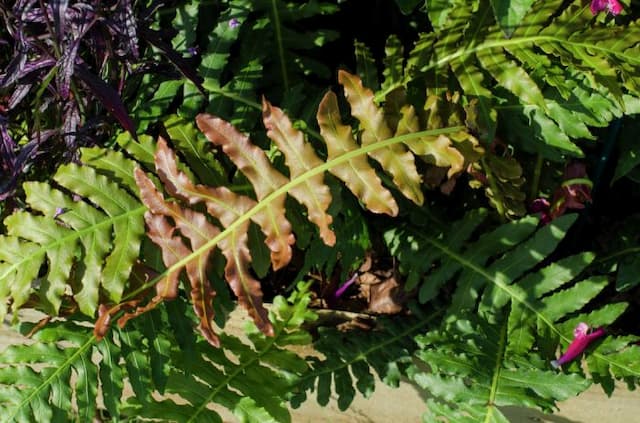
![Dwarf Brazilian tree fern [Eruption]](/_next/image?url=https%3A%2F%2Fplants-admin.emdemapps.com%2Fimages%2Fplants%2F%2Fimages%2F604b5592bbce2.png&w=640&q=75)
